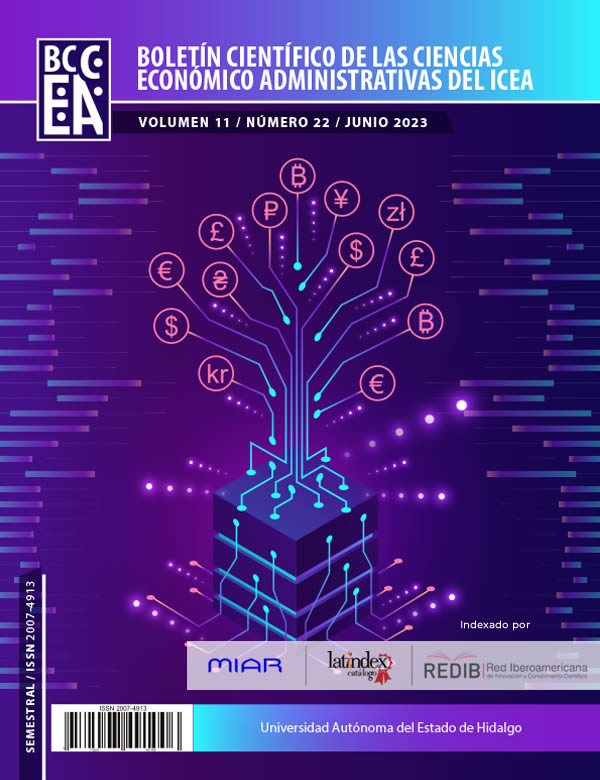Economic and Environmental Impact of Renewable and Non-Renewable Energies in Mexico
Abstract
The objective of this research is to determine the long-term sustainability of renewable energies and non-renewable energies on the economic and environmental indicators of Mexico in the period from 1990 to 2019, through cointegration methods (ARDL and Dynamic Ordinary Least Squares), a based on data on economic growth of GDP, development measured with the Human Development Index and pollution with greenhouse gas emissions, related to the consumption of the aforementioned energies. A long-term relationship is inferred in the non-stationary series. Based on the results, it is suggested to increase the proportion of renewable energies, due to its effects that mean less pollution in the country, but moderate economic growth.
Downloads
References
Ahdi Noomen Ajmi, Shawkat Hammoudeh, Duc Khuong Nguyen, João Ricardo Sato,. (2015). On the relationships between CO2 emissions, energy consumption and income: The importance of time variation. Energy Economics, 49, 629-638. doi:https://doi.org/10.1016/j.eneco.2015.02.007.
Altamirano, A. Y. (2020). México y su transición energética: un cambio en pro de la energía Renovable. Latin American Developments in Energy Engineering, 26–42. doi:https://doi.org/10.17981/ladee.01.01.2020.3
André, F. J., de Castro, L. M., & Cerda, E. (2009). Universidad Complutense de Madrid. Obtenido de Las energías renovables en el ámbito: https://www.researchgate.net/profile/Francisco-Andre/publication/277269010_Las_energias_renovables_en_el_ambito_internacional/links/5582861308ae12bde6e4c5bf/Las-energias-renovables-en-el-ambito-internacional.pdf
Caraballo Pou, M. Á., & García Simón, J. M. (2017). Energías renovables y desarrollo económico. Un análisis para España y las grandes economías europeas. EL TRIMESTRE ECONÓMICO, 571-609. Obtenido de http://www.scielo.org.mx/pdf/ete/v84n335/2448-718X-ete-84-335-00571.pdf
Catalán Alonso, H. (2021). Impacto de las energías renovables en las emisiones de gases efecto invernadero en México. Problemas del Desarrollo, 59-83. doi:https://doi.org/10.22201/iiec.20078951e.2021.204.69611
CONAE. (2011). Obtenido de Comision Nacional para el Uso Eficiente de Energia: https://www.conae.com.mx/
Damodar N. Gujarati, D. C. (2010). Econometria. México, D. F.: The McGraw-Hill Companies, Inc.
Daniel A. Sanchez-Loor, M. A.-M. (2015). Causality
Analysis between Electricity Consumption, Real Gross Domestic Product, Foreign Direct Investment, Human Development and Remittances in Colombia, Ecuador and Mexico. International Journal of Energy Economics and Policy, 5, 746-753. doi:https://dergipark.org.tr/en/pub/ijeeep/issue/31914/351001
David A. Dickey & Wayne A. Fuller. (1981). Likelihood Ratio Statistics for Autoregressive Time Series with a Unit Root. Econometrica, 49, 1057-1072. Obtenido de http://www.jstor.org/stable/1912517
Denis Kwiatkowski, Peter C.B. Phillips, Peter Schmidt, Yongcheol Shin. (1992). Testing the null hypothesis of stationarity against the alternative of a unit root: How sure are we that economic time series have a unit root? Journal of Econometrics, 54, 159-178. doi:https://doi.org/10.1016/0304-4076(92)90104-Y
Faisal Mehmood Mirza, A. K. (2017). Energy consumption, carbon emissions and economic growth in Pakistan: Dynamic causality analysis. Renewable and Sustainable Energy Reviews, 1233-1240. doi:https://doi.org/10.1016/j.rser.2016.10.081.
García , H., Corredor, A., Calderón, L., & Gómez, M. (Octubre de 2013). Fedesarrollo. Obtenido de Análisis costo beneficio de energías renovables no convencionales en Colombia: https://repository.fedesarrollo.org.co/bitstream/handle/11445/331/Repor_Octubre_2013_Garcia_et_al.pdf?sequence=3&isAllowed=y
Gibrán S. Alemán-Nava, V. H.-F.-C.-C.-F. (abril de 2014). Renewable energy research progress in Mexico: A review. Renewable and Sustainable Energy Reviews, 32, 140-153. doi:https://doi.org/10.1016/j.rser.2014.01.004.
Giles, D. (2013). Modelos ARDL - Parte II - Pruebas de límites. Obtenido de https://davegiles.blogspot.com/2013/06/ardl-models-part-ii-bounds-tests.html
Gómez, Mario, Ciarreta, Aitor, & Zarraga, Ainhoa. (2018). Consumo de energía, crecimiento económico y comercio: Un análisis de causalidad para México. EconoQuantum, 53-72. doi:https://doi.org/10.18381/eq.v15i1.7112
Harris, R., & Sollis, R. (2003). Applied Time Series Modelling and Forecasting. Hoboken: John Wiley and Sons.
Hayakawa, Kazuhiko y Kurozumi, Eiji. (2006). The Role of "Leads" in the Dynamic OLS Estimation of Cointegrating Regression Models. Instituto de Investigación Económica, Universidad de Hitotsubashi. Obtenido de https://EconPapers .repec.org/RePEc:hst:hstdps:d06-194.
Johansen, S. (1988). Statistical analysis of cointegration vectors. Journal of Economic Dynamics and Control, 12, 231-254.
Jonathan, H. P. (2021). Efecto del consumo de energía renovable en las emisiones de gases de efecto invernadero en países con ingresos bajos y altos. Acta Universitaria, 31. doi:https://doi.org/10.15174/au.2021.3030
Kraft, J., y A. Kraft. (1978). On the Relationship between Energy and GNP. Journal of Energy and Development, 401-203.
Maddala, G. S. (1996). Introduccion a la Econometria. España: Prentice Hal.
Montalvo, J. G. (1995). Comparing cointegrating regression estimators: Some additional Monte Carlo results. Economics Letters, 48, 229-234. doi:https://doi.org/10.1016/0165-1765(94)00632-C
Newey, W. K., & West, K. D. (1987). A Simple, Positive Semi-Definite, Heteroskedasticity and Autocorrelation Consistent Covariance Matrix. Econometrica, 55, 703–708. doi:https://doi.org/10.2307/1913610
Pesaran, M.H., Y. Shin, R. J. Smith. (2001). Bounds testing approaches to the analysis of level relationships. Journal of Applied Econometrics, 16, 289-326.
Peter CB Phillips, Pierre Perron. (1988). Testing for a unit root in time series regression. Biometrika, 75, 335–346. doi: https://doi.org/10.1093/biomet/75.2.335
Rafael Alvarado, Pablo Ponce, Raquel Alvarado, Katerine Ponce, Viviana Huachizaca, Elisa Toledo. (2019). Sustainable and non-sustainable energy and output in Latin America: A cointegration and causality approach with panel data. Energy Strategy Reviews, 26. doi:https://doi.org/10.1016/j.esr.2019.100369.
Robert F. Engle, C. W. J. Granger. (1987). Co-Integration and Error Correction: Representation, Estimation, and Testing. Econometrica, 55, 251-276. Obtenido de http://www.jstor.org/stable/1913236
Saikkonen, P. (1992). Estimación y prueba de sistemas cointegrados mediante una aproximación autorregresiva. Teoría econométrica , 1-27.
SENER. (24 de Diciembre de 2015). Gobierno de Mexico. Obtenido de Atlas nacional de Zonas con alto potencial de Energías Limpias: https://dgel.energia.gob.mx/azel/
SENER. (2020). Recuperado el 2022, de Secretaria de Energia: https://sie.energia.gob.mx/bdiController.do?action=temas
Stock, J. y M. Watson. (1993). A Simple Estimator of Cointegrating Vectors in Higher Order Integrated Systems. Econometrica, 783-820.
Copyright (c) 2023 Josue Atzin Ramos Aguilar, Zeus Salvador Hernández Veleros

This work is licensed under a Creative Commons Attribution-NonCommercial-NoDerivatives 4.0 International License.












